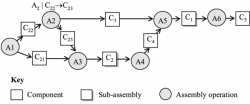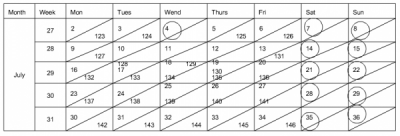Capacity Requirements Planning
The CRP occurs at the level of the MRP. Planned orders from the MRP and open shop orders (schedule receipts) are converted into demand for time in each work center in each time period. This process takes into consideration the lead times for operations and offsets the operations at work centers accordingly. In considering open shop orders, its accounts for work already done on a shop order. Capacity planning is
the most detailed, complete and accurate of the capacity planning techniques. Because of the detail, a great amount of data and computation are required.
Routing–Based and Rate–Based Capacity Planning (Oracle EBS)
You can plan capacity for individual resources assigned to operations on routings, or you can plan capacity by production line. Required and available capacity for routing– based plans are stated in hours per week per resource, and for rate–based plans by production rate per week per line. Resource requirements are also based on the effective date ranges in routings.
The inputs need for a CRP are open shop orders, planned order releases, routings, time standards, lead times and work center capacities. This information can be obtained from the following:
- Open order file,
- MRP,
- Routing file,
- Work center file
Open order file An open shop order appears as a scheduled receipt on the MRP. It is released order for a quantity of a part to be manufactured and completed on a specific date. The open order file is a record of all the active shop orders. It can be maintained manually or as a computer file.
Planned order releases Data from Material Requirements Planning that tells when a production order should start (it is offset by the appropriate lead time).They are inputs to the CRP process in assessing the total capacity required in future time periods.
A suggested production, purchase or replenishment order generated by an MRP or other planning system to meet a projected shortage against desired safety stock levels. The shortage date becomes the due date, the release date is backward scheduled based on lead time, and the quantity is based on the specified lot size. Planned orders for upper level items create requirements for lower level components, and MRP generations delete existing planned orders and regenerate new ones based on changes in requirements. Planned orders must be firmed or accepted before releasing to production or to a vendor.
Routing file A routing is a path that work follows from work center to work center as it is completed. Routing is specified on a route sheet or, in a computer-based system, in a route file. A routing file should exist for every component manufactured and contain the following information:
A routing is a path that work follows from work center to work center as it is completed. Routing is specified on a route sheet or, in a computer-based system, in a route file. A routing file should exist for every component manufactured and contain the following information:
- Operations to be performed,
- Sequence of operations,
- Work centers to be used,
- Possible alternate work centers,
- Tooling needed at each operations,
- Standard times: setup times and run times per piece.
Work center file A work center is composed of a number of machines or workers capable of doing the same work. A work center file contains information on the capacity and move, wait and queue times associated with the center.
The move time is the time normally taken to move material from one workstation to another. The wait time is the time a job is at a work center after completion and before being moved. The queue time is the time a job waits at a work center before being handled. Lead time is the sum of queue, setup, run, wait, and move times.
Shop calendar Another piece of information needed is the number of working days available. The Gregorian calendar has some serious drawbacks for manufacturing planning and control. The months do not have the same number of days, holidays are spread unevenly throughout the year and the calendar does not work on a decimal base.
Another piece of information needed is the number of working days available. The Gregorian calendar has some serious drawbacks for manufacturing planning and control. The months do not have the same number of days, holidays are spread unevenly throughout the year and the calendar does not work on a decimal base.
How many working days do we really have?
Because of this problem, it is desirable to develop a shop calendar.